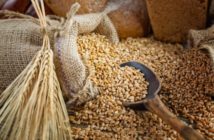Times of India | IPSHITA MITRA,TNN
A slice of Morocco on India’s plate (Thinkstock photos/Getty Images)
Many of us would initially be a little dazed upon hearing about a Moroccan Food Festival in town. There could be two reasons behind our surprise, a) We don’t find Moroccan dishes to be often featuring on menus at food joints or b) Our ignorance in general hold us back from getting into the nitty-gritty’s of African food culture.
The 10-day long celebration of North African cuisine at The Cafe in The Hyatt Regency, New Delhi is a boon for us to explore and experience a culinary culture that is not only in many ways than one similar to Indian cooking style but also something our food consciousness is unaware of.
A warm welcome with Moroccan tea: Maghreb mint tea is a drink of hospitality in North Africa and tradition has it that it is prepared by the head of the family, yes, the man and not the woman of the house unlike most Indian households. Here at the festival, we too sipped on the Moroccan Mint tea as a refreshing precursor to an elaborate spread to follow soon. The pouring of tea aroused the quiet mint leaves inside the glass with life while we watched the magic unfold. What ensued was a series of sumptuous dishes we couldn’t get enough of. A short walk through the buffet stations with the chef made us marvel at the array of delicious African food we couldn’t resist any longer digging in. The tiny lamb samosas with a thin crust and stuffed with minced meat was the hands down winner in entree. Who wouldn’t go for a second helping of that? The Seafood Pastilla that we gorged on was a pie with crispy layers and a delicious filling of shrimps and rice noodles.
Friday is ‘Couscous Day’: There is a unique blend of food and religion in Morocco that unites people in a heart warming manner. Our Chef and host of the evening Chef Lahcen (pronounced Hasan) Bechchar, shared an interesting trivia with us. “Friday in Morocco is known as the ‘Couscous Day’, also a holy day when Muslims offer prayers in mosques and connect to the divine power. On their return, the meal that they are served comprises couscous (a North African Berber dish that resembles rice, only its grains are tinier and is cooked with steam) as one of the main dishes traditionally savoured with almost seven kinds of vegetables and assortments of soups,” Chef adds. That evening we were not on our way back from a spiritual tour but we did not miss the opportunity to relish the dish with a similar community feeling that binds people together in the spice-rich country of Morocco.
Slurpy, soupy and silky: To keep you partially informed about the soups on offer at this festival would be unfair and with every slurp, the taste gets even better. Among the many options that included Harira soupe, lintel, vegetable, shourba and pumpkin; we decided to pick the often misunderstood pumpkin and what followed was absolutely delightful. For those who are not big fans of this vegetable can dispel all myths with this sweet, pleasant and subtle soup. You can pair it with slices of bread which is considered the base food in the country.
Chicken Tagine, the star dish: Lemon, as we are informed by our chef is one of the most used and preserved ingredients in Moroccan cuisine. The juice lends a zesty flavour otherwise missing from the dish. The Spring Chicken Tagine with Lemon Confit that we tried made for a spectacular display as the fresh green olives dressed the dish quite well. Beef is the preferred choice there that, however, could not make its way into the Indian kitchen here. As we moved ahead with our course, we simply could not take our eyes off the gorgeous Red Snapper fish that beckoned us while we readied our plates to be served portions of the same. Needless to say, a cracker of a dish!
The ‘Moroccan’ spice route: Subtle on the palate, yet textured and spice-coated, a Moroccan meal shows mercy to its diners who are not really warriors on the spice front. Slow cooking (some preparations take upto 3 hours); olive oil and the coming together of spices like saffron, cumin and powdered ginger are the strengths of Moroccan delicacies. It is super healthy because the culinary process involves fresh vegetables straight out of the farms and spices imported from India. Chef explains the geographical ties that India shares with Morocco for centuries on pretext of trade exchange. “The business route from the Indian Ocean to Marrakesh (former imperial city in Morocco) helped develop a relationship and one could guess that India and Morocco found their common ground in food.”
Speaking of the culinary connect we ask how many Indians take to Moroccan food and the Chef who has been in the industry since 1994 hesitates a little but positive nonetheless, says, “They don’t like to try something new, it is only when you push them do they recognise and appreciate the food.”
Desserts all the way… We were quite full to the brim but excuses are always in place for desserts. ‘Oum Ali’ also ‘Omali’ means Mother of Ali and touted as the mother of Egyptian warm desserts. Made with puff pastry (similar to bread and butter pudding), this sweet is an explosion of dried fruits, lots of cream and nuts and we certainly loved this Arabic specialty to bits. Moroccan rice pudding with pistachios and rose essence, Kataif, Orange & Cinnamon tart, Mohalabi and Baklava were some of the other showstopping desserts.
Must-try dishes: Pork Tagine with dried fruits from the grill, Spring Chicken Tagine with Lemon Confit, Kefta Lamb (Lamb samosa in spring roll), Couscous with 7 vegetables and Fish Tagine with vegetables.
Dine this season, the Moroccan way!
Where: The Cafe, The Hyatt Regency, New Delhi
When: On till September 16, 2012
Timings: Lunch: 12- 3pm, Dinner: 7- 11pm
ipshita.mitra@indiatimes.co.in
.






